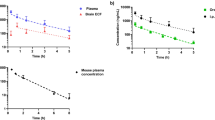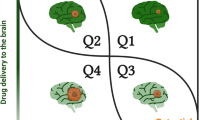Summary
The relative affinity of six anticancer amino acid drugs for the neutral amino acid carrier of the blood-brain barrier was examined in rats using an in situ brain perfusion technique. Affinity was evaluated from the concentration-dependent inhibition ofl-[14C]-leucine uptake into rat brain during perfusion at tracer leucine concentrations and in the absence of competing amino acids. Of the six drugs tested, five, including melphalan, azaserine, acivicin, 6-diazo-5-oxo-l-norleucine, and buthionine sulfoximine, exhibited only low affinity for the carrier, displaying transport inhibition constants (K i, concentrations producing 50% inhibition) ranging from 0.09 to 4.7 mM. However, one agent −d,l-2-amino-7-bis[(2-chloroethyl)amino]-1,2,3,4-tetrahydro-2-naphthoic acid (d,l-NAM) — demonstrated remarkably high affinity for the carrier, showing aK i value of ∼0.2 μM. The relative affintty (1/K i) ofd,l-NAM was >100-fold that of the other drugs and >10-fold that of any compound previously tested. As the blood-brain barrier penetrability of most endogenous neutral amino acids is related to their carrier affinity, the results suggest thatd,l-NAM may be a promising agent which may show enhanced uptake and distribution to brain tumors.
Similar content being viewed by others
References
Begleiter A, Lam H, Grover J, Froese E, Goldenberg G (1979) Evidence for active transport of melphalan by amino acid carriers in L5178Y lymphoblasts in vitro. Cancer Res 39: 353–359
Bennett LL (1975) Grutamine antagonists. In: Sartorelli AC, Johns DG (eds) Antineoplastic and immunosuppressive drugs, part II. Springer Verlag, Berlin, Heidelberg New York, pp 484–511
Brightman MW (1977) Morphology of blood-brain interfaces. Exp Eye Res [Suppl]: 1–25
Chastain JE, Borchardt RT (1990) Acivicin transport across bovine brain microvessel endothelial cell monolayers: a model of the blood-brain barrier. Neurosci Res Commun 6: 51–55
Cornford EM, Oldendorf WH (1975) Independent blood-brain barrier transport systems for nucleic acid precursors. Biochim Biophys Acta 394: 211–219
Fekete I, Griffith OW, Schlageter KE, Bigner DD, Friedman HS, Groothuis DR (1990) Rate of buthionine sulfoximine entry into brain and xenotransplanted human gliomas. Cancer Res 50: 1251–1256
Fisher B, Carbone P, Economons S (1975)l-Phenylalanine mustard in the management of primary breast cancer. N Engl J Med 292: 117–122
George RP, Poth JL, Gordon D, Schrier SL (1977) Multiple myeloma-intermittent combination chemotherapy compared to continuous therapy. Cancer 29: 1665–1670
Greig NH (1989a) Drug delivery to the brain by blood-brain barrier circumvention and drug modification. In: Neuwelt EA (ed) Implications of the blood-brain barrier and its manipulation, vol 1. Plenum Press, New York, pp 311–367
Greig NH (1989b) Brain tumors and the blood-tumor barrier. In: Neuwelt EA (ed) Implications of the blood-brain barrier and its manipulation, vol 2. Plenum Press, New York, pp 77–106
Greig NH, Momma S, Sweeney DJ, Smith QR, Rapoport SI (1987) Facilitated transport of melphalan at the rat blood-brain barrier by the large neutral amino acid carrier system. Cancer Res 47: 1571–1576
Griffith OW (1982) Mechanism of action, metabolism, and toxicity of buthionine sulfoximine and its higher homologs, potent inhibitors of glutathione synthesis. J Biol Chem 257: 13704–13712
Groothuis DR, Molnar P, Blasberg RG (1984) Regional blood flow and blood-to-tissue transport in five brain tumor models. Prog Exp Tumor Res 27: 132–152
Haines DR, Fuller RW, Ahmad S, Vistica DT, Marquez VE (1987) Selective cytotoxicity of a System L specific amino acid nitrogen mustard. J Med Chem 30: 542–547
Hildebrand J (1985) Current status of chemotherapy of brain tumours. Prog Exp Tumor Res 29: 152–166
Huber KR, Rosenfeld H, Roberts J (1988) Uptake of glutamine antimetabolites 6-diazo-5-oxo-l-norleucine (DON) and, acivicin in sensitive and resistant tumor cell lines. Int J Cancer 41: 752–755
Kubo O, Himuro H, Inoue N, Tajika Y, Tohyama T, Sakairi M, Yoshida M, Kaetsu I, Kitamura K (1986) Treatment of malignant brain tumours with slow-releasing anticancer drug-polymer composites. No Shinkei Geka 14: 1189–1195
Leo A, Hansch C, Elkins D (1971) Partition coefficients and their uses. Chem Rev 71: 525–616
Levin VA (1987) Pharmacokinetics, and central nervous system chemotherapy. In: Hellmann K, Carter S (ed), Fundamentals of cancer chemotherapy. McGraw-Hill, New York, pp 28–40
Levin VA, Patak CS, Landahl HD (1980) Heuristic modeling of drug delivery to malignant brain tumors. J Pharmacokinet Biopharm 8: 257–296
Miller RG (1966) Simultaneous statistical inference. McGraw-Hill, New York, pp 76–81
Momma S, Aoyagi M, Rapoport SI, Smith QR (1987) Phenylalanine transport across the blood-brain barrier as studied with the in situ brain perfusion technique. J Neurochem 48: 1291–1300
Neuwelt EA, Dahlborg SA (1989) Blood-brain barrier disruption in the treatment of brain tumors: clinical implications. In: Neuwelt EA (ed) Implications of the blood-brain barrier and its manipulation, vol 2. Plenum Press, New York, pp 195–261
O'Dwyer PJ, Alonso MT, Leyland-Jones B (1984) Acivicin: a new glutamine antagonist in clinical trials. J Clin Oncol 2: 1064–1071
Oldendorf WH (1973) Stereospecificity of blood-brain barrier permeability to amino acids. Am J Physiol 224: 967–969
O'Tuama LA, Phillips PC, Strauss LC, Uno Y, Smith QR, Dannals RF, Wilson AA, Ravert HT, Lafrance ND, Wagner HN (1990) Two-phase [11C]-methionine PET scanning in the diagnosis of childhood brain tumors. Pediatr Neurol 6: 163–170
Oxender DL, Christensen HN (1963) Distinct mediating systems for the transport of neutral amino acids by the Ehrlich cell. J Biol Chem 238: 3686–3699
Pardridge WM (1977) Kinetics of competitive inhibition of neutral amino acid transport across the blood-brain barrier. J Neurochem 28: 103–108
Piver M, Barlow J, Lee F (1975) Sequential therapy for advanced ovarian adenocarcinoma: operation, chemotherapy, second-look laprotomy, and radiation therapy. Am J Obstet Gynecol 122: 355–357
Posner JB (1977) Management of central nervous system metastases. Semin Oncol 4: 81–91
Preston RL, Schaeffer JF, Curran PF (1974) Structure-affinity relationships of substrates for the neutral amino acid transport system in rabbit ileum. J Gen Physiol 64: 443–467
Rama B, Mandel T, Jansen J, Dingeldein E, Mennel HD (1987) The intraneoplastic chemotherapy in a rat brain tumour model utilizing methotrexate-polymethylmethacrylate pellets. Acta Neurochir 87: 70–75
Ricardi R, Bleyer WA, Poplack DG (1983) Enhancement of delivery of antineoplastic drugs into cerebrospinal fluid. In: Wood JH (ed) Neurobiology of cerebrospinal fluid, vol 2. Plenum Press, New York, pp 453–466
Robinson PR, Rapoport SI (1990) Model of drug uptake by brain tumors: effects of osmotic treatment and of diffusion in brain. J Cereb Blood Flow Metab 10: 153–161
Schober O, Duden C, Meyer GJ, Muller JA, Hundeshagen H (1987) Non selective transport of [11C-methyl]-l-andd-methionine into a malignant glioma. Eur J Nucl Med 13: 103–105
Segal IH (1975) Enzyme kinetics. John Wiley and Sons, New York, pp 100–125
Smith QR, Takasato Y, Sweeney DJ, Rapoport SI (1985) Regional cerebrovascular transport of leucine as measured by the in situ brain perfusion technique. J Cereb Blood Flow Metab 5: 300–311
Smith QR, Momma S, Aoyagi M, Rapoport SI (1987) Kinetics of neutral amino acid transprot across the blood-brain barrier. J Neurochem 49: 1651–1658
Smith QR, Aoyagi SI, Rapoport SI (1989) Structural specificity of the brain capillary neutral amino acid transporter. Soc Neurosci Abstr 15: 1025
Spector R (1986) Nucleosice and vitamin homeostasis in the mammalian central nervous system. Ann NY Acad Sci 481: 221–230
Takasato Y, Rapoport SI, Smith SR (1984) An in situ brain perfusion technique to study cerebrovascular transport in the rat. Am J Physiol 247: H484-H493
Tator CH, Wassenaar W (1977) Intraneoplastic injection of methotrexate for experimental brain-tumor chemotherapy. J Neurosurg 46: 165–174
Vistica DT (1983) Cellular pharmacokinetics of the phenylalanine mustards. Pharmacol Ther 22: 379–405
Vistica DT, Ahmad S, Fuller R, Hill J (1986) Transport and cytotoxicity of amino acid nitrogen mustards: implications for design of more selective antitumor agents. Fed Proc 45: 2447–2450
Williams MG, Earhart RH, Bailey H, McGovern JP (1990) Prevention of central nervous system toxicity of the antitumor antibiotic acivicin by concomitant infusion of an amino acid mixture. Cancer Res 50: 5475–5480
Author information
Authors and Affiliations
Rights and permissions
About this article
Cite this article
Takada, Y., Greig, N.H., Vistica, D.T. et al. Affinity of antineoplastic amino acid drugs for the large neutral amino acid transporter of the blood-brain barrier. Cancer Chemother. Pharmacol. 29, 89–94 (1991). https://doi.org/10.1007/BF00687316
Received:
Accepted:
Issue Date:
DOI: https://doi.org/10.1007/BF00687316




